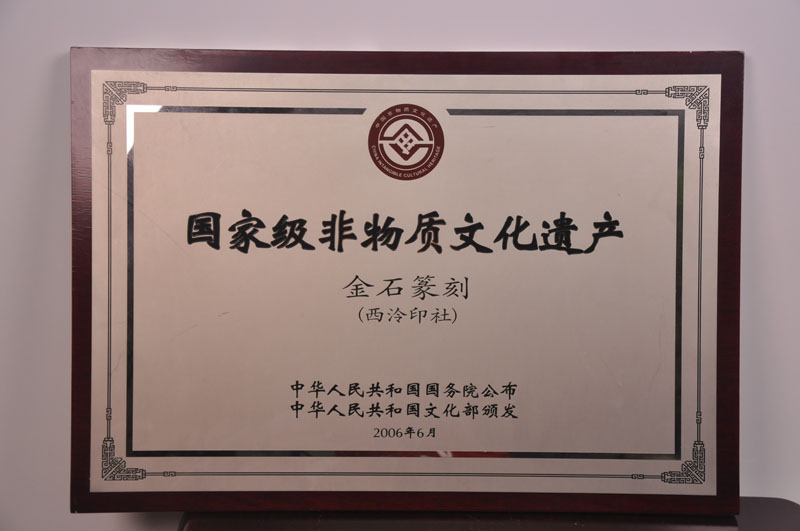金石篆刻(西泠印社)国家级非物质文化遗产

西泠印社创立于1904年(清光绪三十年),是中国现存历史最悠久的文人艺术社团,也是中国第一个以金石篆刻为主的专业学术团体。西泠印社在中华人民共和国民政部注册登记,但在日本、韩国、新加坡、马来西亚及东南亚地区也享有很高的知名度,是在传统汉文化圈有崇高地位、具有国际影响力的国家级社团组织。
创立百余年来,西泠印社以“保存金石、研究印学,兼及书画”为宗旨,以篆刻创作和印学研究为主,同时致力于书法、绘画、古典诗文、收藏鉴定、考古、文字等相关学科领域,注重传统文人综合文化素养的修为。西泠印社以现代意义的社团组织形式从事古典的艺术探索,以宽松的运作理念主张艺术的多元性。每年在春秋两季组织社员聚会,举办艺术展览、学术研讨、创作笔会和鉴赏交流活动,在传统文化土壤日渐衰微的现代文化环境下,依然生动完好地保存着具有传统文人气质的组织文化形态。西泠印社现有社员506人,分布在中国、日本、韩国、新加坡、马来西亚、法国、美国、加拿大、捷克等国家,基本囊括了海内外金石篆刻界的中坚力量,也承载着当代金石篆刻艺术传承发展的重任。
西泠印社拥有作为国家级文物保护单位的孤山社址、国家级的专业博物馆——中国印学博物馆,同时又是中华人民共和国首批国家级非物质文化遗产代表作“金石篆刻(西泠印社)”项目的传承代表组织。2009年,“中国篆刻艺术”入选联合国教科文组织“世界非物质文化遗产项目”,西泠印社为主要传承代表组织,中国的篆刻和印章艺术有机会被更多地区和国家的人们所了解和认识。
印章是人类文明发展进程中的一个重要元素,古埃及、巴比伦、苏美尔、中国等多个文明形态都曾出现过契刻形式的文字刻符,但伴随以这种形式诞生的文字体系一直传承延续、至今仍具有生命力的,惟有中国的印章。即使仅从使用方式和形制上看,中国印章也具有不同于其他文明中“印记”的独特个性。中国印章是中华历史与文明的重要载体之一,数千年来普遍应用于社会生活,并由于文人审美趣味的介入而发展出一系列的程式和规范,产生了众多艺术流派,进而衍生出文人结社等丰富的社会文化生态,成为中华文明的重要组成部分。
Established in 1904 (the 30th year during the reign of Emperor Guangxu in Qing Dynasty), Xiling Seal Engraver’s Society is a society of literati and artists with the longest history among those still existing in China and is also China’s first professional academic organization specializing in stone seal carving. Xiling Seal Engraver’s Society was registered at the Ministry of Civil Affairs of the People’s Republic of China, but it also enjoys a high reputation in Japan, South Korea, Singapore, Malaysia and Southeast Asia. It is a national-level society which takes up an esteemed position in the circle of traditional Chinese culture and has international influence.
Since its establishment over 100 years ago, Xiling Seal Engraver’s Society has always been sticking to the tenet of “Preserving stones, studying seal theories and integrating calligraphy and painting”. While focusing on seal carving creations and seal studies, it is also dedicated to related fields of study such as calligraphy, painting, classical poems and essays, collection appraisal, archaeology and characters, and pays attention to the traditional cultural accomplishments of literati and scholars. Xiling Seal Engraver’s Society is engaged in artistic exploration of classical in the form of social organization with modern meanings. It advocates diversity of art based on broad operation philosophies. In spring and autumn every year, member party is organized, at which activities such as art exhibition, academic seminar, creation forum and appraisal communication are held. Under the modern culture context in which the traditional culture gradually declines, we still preserve the complete organizational culture form which has temperament traditional literati and scholars. At present, Xiling Seal Engraver’s Society has 506 members distributed in countries like China, Japan, South Korea, Singapore, Malaysia, France, the US, Canada and the Czech Republic, basically covering backbones in the circle of stone seal carving at home and abroad. It also undertakes the significant task of carrying over and developing the contemporary art of stone seal carving.
With Gushan Shezhi site, a cultural relic under state protection, and China Seal Studies Museum, a professional museum of national level, Xiling Seal Engraver’s Society is also the carry-over and representative organization of the project of “Stone Seal Carving (Xiling Seal Engraver’s Society)” in representative works of the first group of national-level cultural heritages of the People’s Republic of China. In 2009 “The Art of Chinese Seal” jointly declared by Xiling Seal Engraver’s Society and China Academy of Seal Engraving, Chinese National Academy of Arts, successfully entered the UNESCO Intangible Cultural Heritage List. Thus, the seal engraving and seal art of China have opportunities to be known and recognized by more people in regions and countries all over the world.
Seal is an important element in the course of development of human civilization. In Ancient Egypt, Babylon, Sumeria, China and other cultural forms, character carved symbols in the form of inscriptions on oracle bones were once found. However, with pass-down and continuation of this newly borne character system, the Chinese seal is the only one that is still of vitality. From the perspective of the use method and the shape, Chinese seal also has its uniqueness which is different from “imprints” in other civilizations. Chinese seal is an important carrier of Chinese history and civilization, which has been commonly applied in social life for over thousand years. Further more, due to the intervention of aesthetic interest of literati and scholars, a series of programs and standards of Chinese seal has been developed, and various artistic schools have come into being, thus deriving abundant social cultural ecology such as formation of association by literati and scholars, making Chinese seal a significant part of Chinese civilization.

